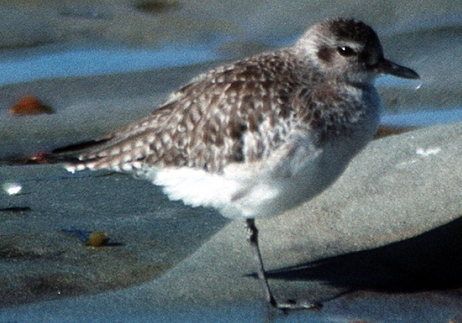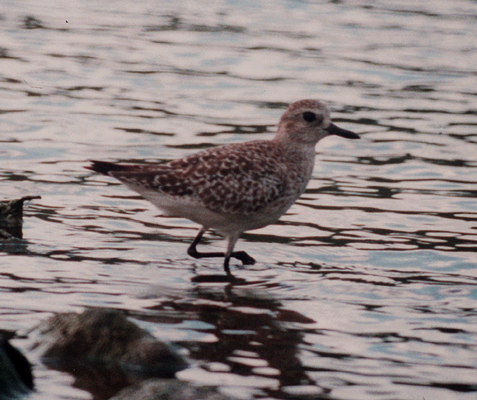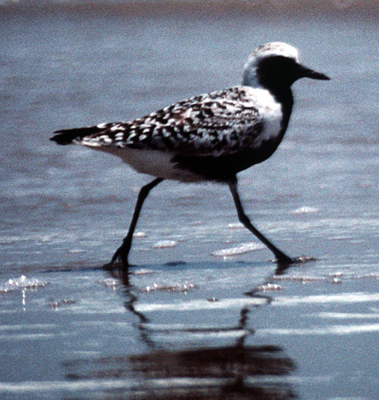|
Black-bellied Plover Pluvialis squatarola Chorlo Gris, Playero Cabezón
|
 |
|
Non-breeding plumage -
Photo: G. Beaton
|
|
Black-bellied Plover Pluvialis squatarola Chorlo Gris, Playero Cabezón
|
 |
|
Non-breeding plumage -
Photo: G. Beaton
|
|
IDENTIFICATION: Plovers have a relatively short bill and short neck, which give them a distinct profile compared to many other shorebirds. The Black-bellied Plover is a large shorebird with a light belly, and a gray-brown back, speckled with white in winter plumage. It has a large-headed and big-eyed look. Before migrating north, the Black-bellied Plover molts into a breeding plumage with black undersides. In flight, the base of the underwings (axillars) is black. Length: 28-29 cm.; weight: 180 g. VOICE: On the winter grounds, it gives a slurred whistle, and sometimes a three-note contact call "Pee-o-wee." Audio (M. Oberle). HABITAT: Mudflats, edges of mangroves, salt flats, and tidal pools on sandy beaches. HABITS: Feeds alone or in loose association with other shorebird species who benefit from the plover’s habit of quickly sounding the alarm at approaching danger. It feeds on a wide variety of marine worms, insects and small molluscs. Its large eyes are presumed to be an adaptation to feeding at night. Plovers typically run instead of walk, and sometimes swim short distances across small pools. At high tide, small flocks roost on pilings, dikes, in mangroves, on rocks, or on protected higher beaches. Most winter visitors arrive in August or September and leave by late April, but some birds---presumably one-year old birds that have never bred---spend the summer. During the migration north, birds defend small feeding areas from other plovers. On the breeding range in North America, this species prefers high, dry tundra for nesting. The male digs a small scrape nest on a ridge top that gives it a commanding view for quick identification of predators. When the female accepts a nest site, she adds a lining of lichens and grasses. Each of the four eggs is about 16% of the female’s body weight. Both sexes have two large incubation patches (featherless areas of skin on the belly that facilitate transfer of heat). Chicks hatch after 24-27 days of incubation and leave the nest about two days after hatching. The parents brood the young even after they have abandoned the nest, and will lead the chicks to food. The chicks fledge after about 35-45 days. As with many other shorebirds, adult birds migrate south several weeks before the juveniles. The young birds depart several weeks later, finding their way to winter grounds instinctively. This species often does not breed until two or three years old. STATUS AND CONSERVATION: A common species on salt flats and occasionally other beaches and mudflats. Because it is so wary of humans, it was not as seriously impacted as other shorebird species by market hunting in the 19th Century. RANGE: Found over a wide area of coastal habitat in the Old World, where it is called the Grey Plover. In the Western Hemisphere, it nests along the Bering Sea and on the high Arctic islands and coasts of Alaska and Canada. In winter it is restricted to coastal areas from Washington State and Connecticut south along the coasts of Central America and the Caribbean Islands to central Chile and Argentina. A regular location to find this species is at the salt flats at Cabo Rojo. TAXONOMY: CHARADRIIFORMES; CHARADRIIDAE; Charadriinae |
 |
|
Non-breeding plumage -
Photo: G. Beaton
|
 |
|
Non-breeding plumage -
Photo: C. Ruiz
|
 |
|
Breeding plumage - Photo:
G. Beaton
|
 |
|
Breeding plumage - Photo:
G. Beaton
|
|
References Bent, A.C. 1929. Life histories of North American shore birds, part 2. Smithsonian Instit. U.S. National Museum Bull. 146. (Reprinted by Dover Press, NY, 1962). Collazo, J.A., B.A. Harrington, J. Grear, and J.A. Colón. 1995. Abundance and distribution of shorebirds at the Cabo Rojo salt flats, Puerto Rico. J. Field Ornithol. 66:424-438. del Hoyo, J., A. Elliott, and J. Sargatal, eds. 1996. Handbook of Birds of the World, Vol. 3. Hoatzin to Auks. Lynx Edicions, Barcelona. Hayman, P., J. Marchant, and T. Prater. 1986. Shorebirds: an identification guide. Houghton Mifflin, Boston. Paulson, D. 1993. Shorebirds of the Pacific Northwest. Univ Washington, Seattle. Paulson, D. R. 1996. Black-bellied Plover (Pluvialis squatarola). No. 186 in The birds of North America (A. Poole and F. Gill, eds.). Acad. Nat. Sci., Philadelphia, PA, and Am. Ornithol. Union, Washington, D.C. Raffaele, H.A. 1989. A guide to the birds of Puerto Rico and the Virgin Islands. Princeton. Raffaele, H.A. 1989. Una guía a las aves de Puerto Rico y las Islas Vírgenes. Publishing Resources, Inc., Santurce, PR. Raffaele, H.A., J.W. Wiley, O.H. Garrido, A.R. Keith, and J.I. Raffaele. 1998. Guide to the birds of the West Indies. Princeton. Saliva, J.E. 1994. Vieques y su fauna: Vieques wildlife manual. U.S. Fish & Wildlife Service, Boquerón, PR. Wunderle, J.M., Jr., R.B. Waide, and J. Fernández. 1989. Seasonal abundance of shorebirds in the Jobos estuary in southern Puerto Rico. J. Field Ornithol. 60:329-339. Black-bellied Plover, Spanish text Next related species in taxonomic order Previous related species in taxonomic order |